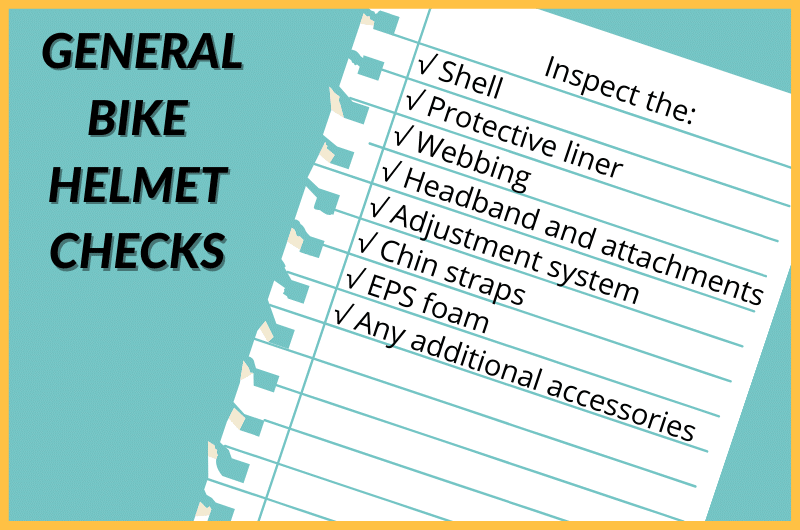The wearing of bicycle helmets is one of the most divisive hot takes of cycling in the 21st century. Academic studies, motoring safety surveys and urban cycling gurus offer a spectrum of analyses as to the reasons why we do or do not wear them. Everyone agrees that they reduce the chances of head-injury.
Once you reach adulthood, your head stops growing, and you get round to making a long-term choice of your lid. Some are aerodynamic, some are packed with additional technology like the MIPS system (which we discuss here), some can have a novelty twist, or be foldable to suit your needs.
They all generally have a core feature of a moulded block of polystyrene foam (EPS), with a polycarbonate covering and thick canvas type adjustable straps. The lifespan of a helmet is not standard as a number of factors influence its deterioration. Knocks, accidents, wear and tear, and even exposure to UV rays all play a part.

Do Bicycle Helmets “Go Bad”?
The erosion of a bicycle helmet will depend on a number of factors. These aren’t just limited to whether it is compromised following a heavy fall or impact. It depends on how beat up you let it get, and how you preserve and treat it. No two helmets will deteriorate at the same rate.
There are often tales of simple human sweat causing a helmet to erode. It’s outside the trading and safety standards to permit a helmet to do this. The main fixed component parts of a safe helmet, which we go over in more detail here, are not susceptible to corrosion by this method.
The UV rays from sunlight can affect the rigidity of the EPS aspect of the helmet. EPS foam (expanded polystyrene foam) is the material that makes up the inner lining of a bike helmet. Given that most helmets can be expected to spend time in the sun, manufacturers put UV inhibitors in the materials to limit degradation. Keeping a helmet behind the glass boot of a vehicle is not a good idea.
When Do Bicycle Helmets Expire?
Some manufacturers will have a replacement date of three, or five, or eight years. Given the range of years, for broadly similar components and design, there are some different driving forces for different companies’ decisions.
Safety standards and new materials may make an older helmet look and feel superfluous.
Modern cycling helmet technologies have developed significantly since the 1970s and 1980s, when a simple band of undercooked-sausage strips covered parts of the top of the head. Hair oils and even cosmetics can contribute to degradation.

Why Do Helmets Only Last X Years?
Wear and tear will play some part in the degradation of a helmet. Day-to-day use and knocks, bumps and scrapes (how many times do you get too close to a wall when locking or unlocking your bike?) all contribute. Weather and local conditions also are a factor.
Depending on use, it is of course possible to make helmets last more than the suggested number of years identified by the manufacturer. The importance of the helmet to some riders safety, confidence and ability cannot be overlooked.
Experts agree that age is not the only factor in the lifespan of a helmet. Added to environmental exposure, certain chemicals and solvents influence its effectiveness. Lifespan might be altered by improvements in technology. We are not talking about expiration from crashes or significant bangs.
Take care over cleaning. Most manufacturers advocate a mild dish soap, and soft cloth or sponge to clean, and storage in a cool, dry place. Treat it with care, and be gentle with it when not being worn.
Obviously companies invest a lot in reports and surveys. A reputation which may have taken years to forge can be destroyed by the negative publicity that would follow a series of accidents where their product did not stand up to the rigours of a crash. Replacing the helmet reduces the chances of compromise to the manufacturer.

Should Bike Helmets Be Replaced After an Accident?
Almost certainly. Most riders are conscious that you MUST replace bicycle helmets after a crash where you have hit your head. Academics and non-profit groups back this up. The foam part of the helmet has been designed for one hit. You may not be able to visually confirm the status of the helmet.
Be grateful that the helmet did its job. In some ways, the protection of the helmet may not even lead the rider to concede that they did actually hit their head. The accident may not occur during a ride. Dropping the helmet on a hard surface can have a lasting effect.
Be careful where you hang or rest your helmet if you’ve paused for coffee or have been asked to remove it – a fall on a concrete floor could be an expensive accident.
Some manufacturers consider replacing helmets for a fee. Give them a ring and see what their position is, or take the time to investigate the options before your next purchase. Have a look online for the replacement procedure.
Remember that a helmet is a potentially life-saving safety device. Also, certain parts of a helmet can be recycled, as we discuss here.

How to Tell if a Helmet is Damaged
Regular inspection is mandatory. It should be straightforward to see if your helmet needs replacing. Cracks to the EPS foam, any dents or imperfections on the hard outer shell, or any wear and tear marks are signs not to be ignored. The helmet should really not be used after this point.
Every component part of a safety device has a use, and if you think a small missing chunk is not a consideration, think again. Have a look inside the vents for any splitting or cracking to the EPS, and if there are any signs of the glue lifting the shell from the foam, it’s time for a new helmet.
How Often Should You Replace Your Helmet?
When talking about a helmet, a life-saving device, the best advice would be to follow each manufacturer’s specific notes and guidance. Some say three years, some five, some say eight years without crashes. Make regular checks a part of your overall bicycle cleaning routine.
The post How Long Do Bike Helmets Last? [When to Replace Helmet] appeared first on Discerning Cyclist.
![How Long Do Bike Helmets Last? [When to Replace Helmet]](https://bicycle.org/wp-content/uploads/2022/04/red-bike-helmet-760x504.png)